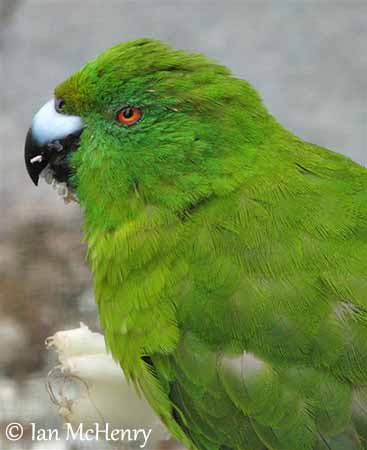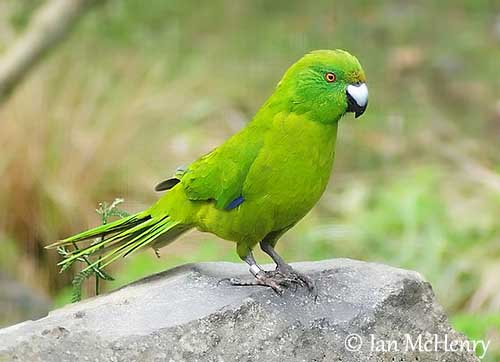
Fr : Perruche des Antipodes
Ang : Antipodes Parakeet
All : Einfarbsittich
Esp : Perico de las Antípodas
Ita : Kakariki verde degli Antipodi
Nd : Groene Karakiri
Sd : Antipodparakit
Photographer:
Ian McHenry
My New Zealand Birds
Text by Nicole Bouglouan
Sources:
HANDBOOK OF THE BIRDS OF THE WORLD vol 4 by Josep del Hoyo-Andrew Elliott-Jordi Sargatal - Lynx Edicions - ISBN: 8487334229
PARROTS OF THE WORLD – An Identification Guide – by Joseph M. Forshaw – Princeton University Press – ISBN 0691092516
BirdLife International (BirdLife International)
Wikipedia (Wikipedia, The Free Encyclopedia)
Antipodes (Green) Parakeet
Cyanoramphus unicolor
Psittaciformes Order – Psittaculidae Family
INTRODUCTION:
The Antipodes Parakeet is endemic to Antipodes Islands in New Zealand. This is a ground-dwelling parrot, threatened by competition for food with mice.
However, the Department of Conservation is currently working on these islands in order to eradicate the mice. As the mice also threaten insects and plants, as well young chicks and eggs, their eradication must be done by non-toxic bait trials, harmless for most bird species. This project is currently underway (July 2014).
The Antipodes Parakeet is classified as Vulnerable, but these actions will probably lead to some increase of the population.
DESCRIPTION OF THE BIRD:
Biometrics:
Length: M: 32 cm – F: 29 cm
Weight: 130 g
The adult has uniform green plumage, and it is the only species without head or rump coloured markings. The underparts can be yellower than the upperparts.
It has bright emerald green face and crown, contrasting with duller nape and breast. On the upperwing, the outer webs of the flight feathers are blue, whereas the fairly long, graduated tail is green with narrow yellow edges.
The long, broad bill is silvery grey with dark tip. The eyes are orange-red. Legs and feet are greyish.
Both sexes are similar.
The juvenile resembles adult with shorter tail. The very young birds have pink-white bill and pale brown eyes.

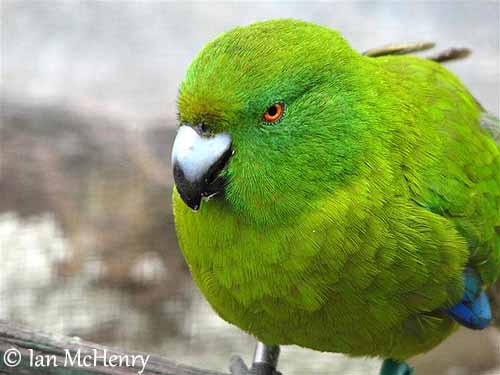
RANGE:
The Antipodes Parakeet is found on Antipodes and Bollons Islands where it is relatively common. However, the species is less frequent on Leeward, Inner Windward and Archway.
HABITAT:
The Antipodes Parakeet usually prefers areas with tall tussocks (Poa litorosa) and sedges on the coastal slopes and along watercourses. It can be seen in areas with ferns and shrubs too.
CALLS AND SONGS:
The Antipodes Parakeet gives loud, deep, resonant “kok-kok-kok-kok-kok-kok” like other Cyanoramphus species, but the sounds are deeper. It also utters softer, low chattering.
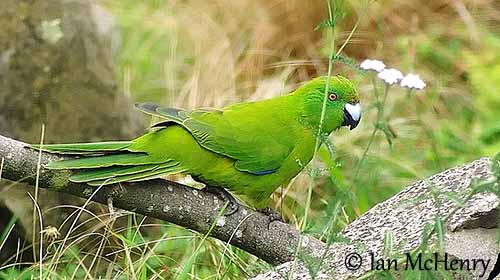
BEHAVIOUR IN THE WILD:
The Antipodes Parakeet’s diet is related to the seasons. It feeds on leaves, mainly those of Poa and Carex, but according to the season, it also feeds on flowers, seeds, berries and carrion. This species is known for its scavenger habits, and it can be seen sometimes on carcasses. It takes eggs and new-borns of penguins and petrels.
It feeds usually in the morning and the late afternoon, before dusk. In the middle of the day, it rests, preens and bathes in sheltered sites. It is seen alone or in pairs, or in small groups of 4-5 birds.
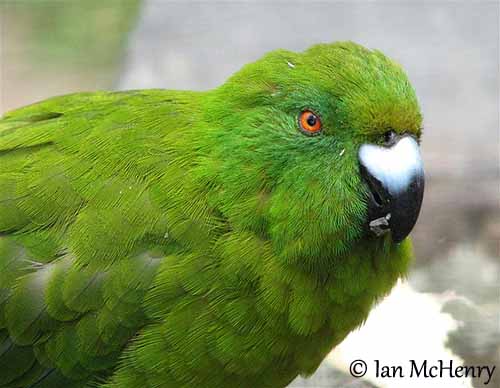
The Antipodes Parakeet is a terrestrial parrot. It nests on the ground, in burrows hidden under tussock grass.
It prefers to walk on the ground or climb into the vegetation when feeding. It reaches rapidly the vegetal cover if disturbed or threatened.
It is sedentary in its reduced range. The flight is strong, swift and slightly undulating. The bird performs rapid, shallow wingbeats, interspersed with glides on outspread wings. It may fly up to 30 metres above the ground on calm days, but it does not like rain and wind.
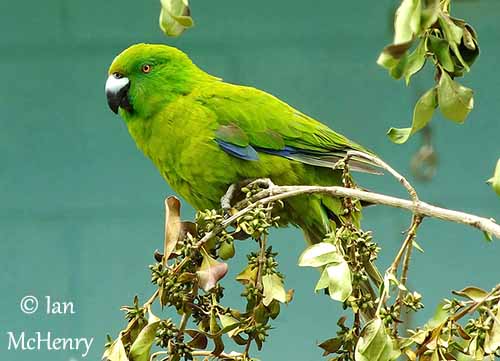
REPRODUCTION OF THIS SPECIES:
The breeding season takes place between October and March.
The Antipodes Parakeet nests in a well-drained burrow excavated beneath dense vegetation in the fibrous peat, or in the thick base of tall grasses. The nest chamber is lined with rootlets or fern scales. The length is about 1 metre or more.
The laying occurs between November and January. The female lays 2-3 white eggs (up to 5-6 in captivity). She performs most of nesting duties such as incubation during 26 days, brooding and feeding the chicks during about two weeks.
She is fed by her mate during this period, and the male takes part in chick feeding until the young are independent at least two weeks after fledging.
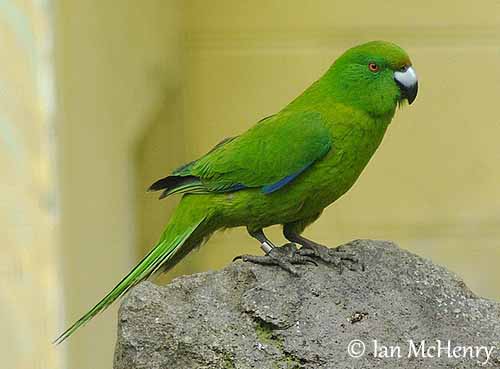
PROTECTION / THREATS / STATUS:
The Antipodes Parakeet has stable population within the reduced range, and the eradication of mice could lead to some increase if there is no other introduction of mammalian predators.
The population size is estimated at 1,300/2,000 mature individuals. This species is living on islands which are nature reserves. In addition, it adapts easily to captivity, and this program will allow to safeguard this nice parakeet.
However, the Antipodes Parakeet is currently classified as Vulnerable.
